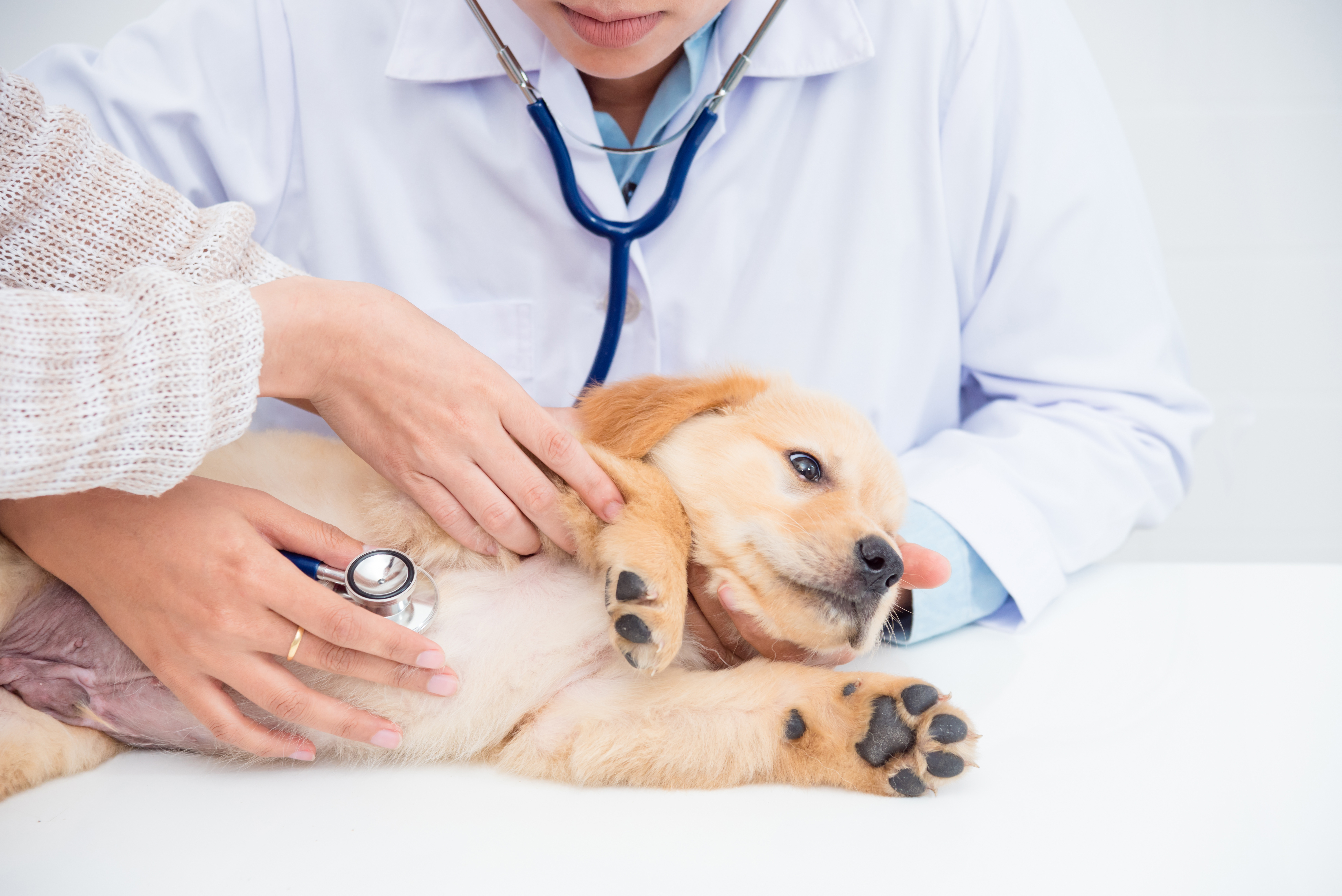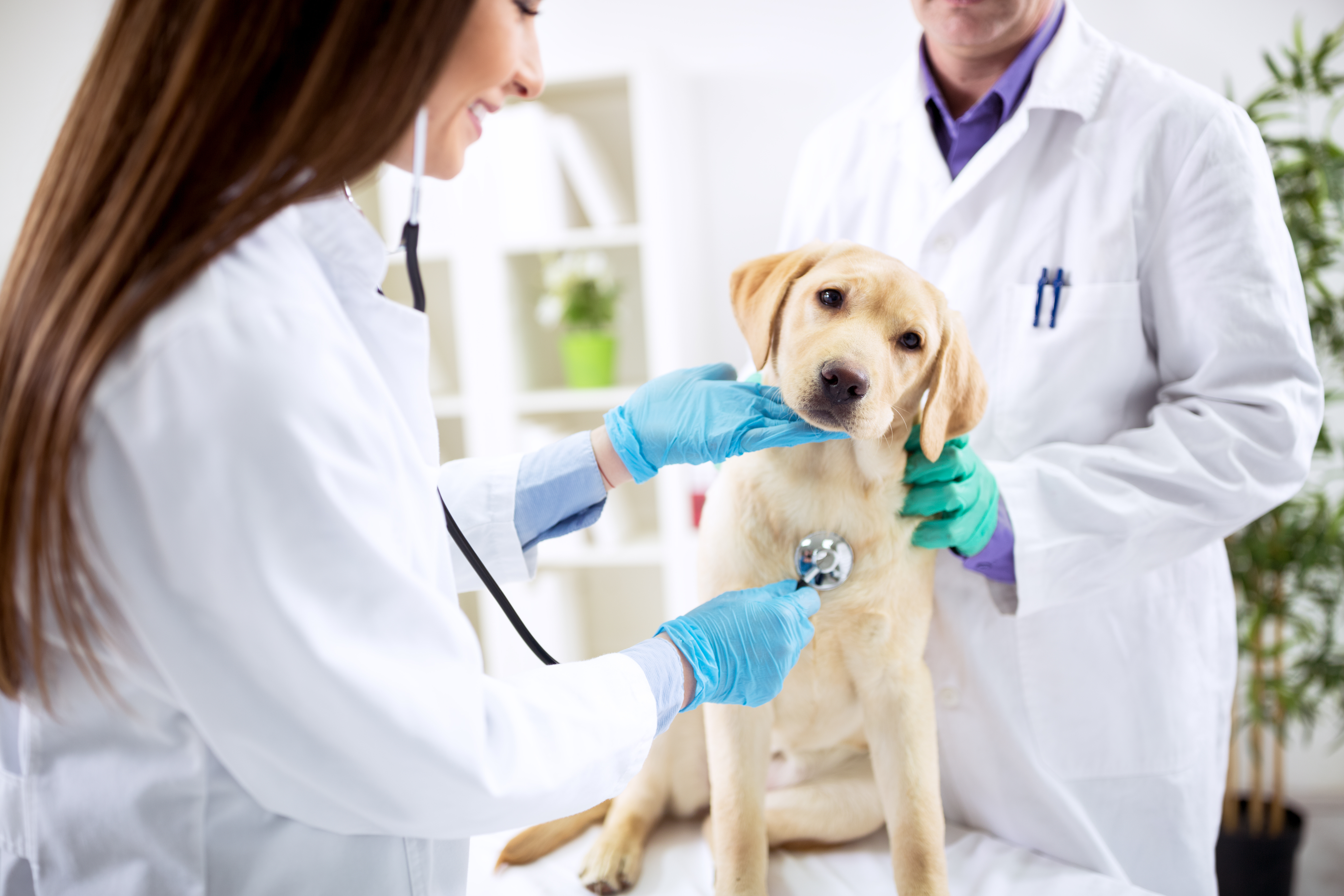Key Takeaways
- Puppies and senior dogs should receive more frequent vet care
- Adult dogs should visit the vet at least once annually
- Medical symptoms such as vomiting require immediate medical care
- More subtle signs (weight loss, lethargy) should also be checked

Veterinary care is essential for dogs, be it emergency vet visits or routine health checkups. Dogs can mask their pain well and accurate diagnosis requires labwork and vet exams. Knowing when to bring your dog to the vet based on their age, breed, lifestyle, and symptoms can help you take better care of them.
Let’s go over the need for routine vet visits, signs you should take your dog to the vet, and how pet insurance can offset high vet bills.

Understanding the Veterinary Needs of Dogs
Preventive care vs. reactive care
Preventive care involves protecting your dog through a good diet, exercise, and vet visits. Instead of treating a medical issue, it seeks to prevent it through better overall health and specific, beneficial pet care.
In contrast, reactive care involves helping a dog recover from illness and accidents. Treating a dog’s acute diseases (such as kidney failure) and injuries is considered reactive veterinary care.
Common health issues and concerns for dogs of different ages
As dogs grow older, they become more prone to geriatric health issues. Senior dogs are likely to get cancer, obesity, sensory impairments, arthritis, kidney disease, dental problems, and heart problems. Dogs over 7 years old should begin seeing the veterinarian more frequently, especially if diagnosed with chronic health conditions.
Breed-specific health conditions
Certain dog breeds are more prone to disease and genetic health conditions. Purebred dogs are predisposed to health issues such as dilated cardiomyopathy, portosystemic shunt, and elbow dysplasia, epilepsy, and early-onset cataracts.
It’s important to research your dog’s potential breed-specific conditions. For example, German Shepherds are more susceptible to hip dysplasia, whereas pugs have more eye problems.
The role of routine vet care for dogs
Routine veterinary care includes vaccinations, parasite control, and dental care. Preventive care aims to improve your dog’s physical status, quality of life, and long-term health. In addition, preventive vet services can reduce the overall vet bills that you will need to pay for dog care.
Vaccinations for dogs include both core vaccines and optional ones. Core vaccines should be administered to all dogs regardless of lifestyle due to the fatality rates of the health concern. Dog core vaccines include distemper, parainfluenza, and rabies.
Parasite exams are important since they allow vets to uncover parasitic infections. A dog with parasites may suffer from vomiting, diarrhea, inappetence, a dull coat, bloating, and lethargy.
Dental care is also essential to dogs. Over 80% of dogs over the age of three have some sort of periodontal disease, which can lead to worse overall health. Since periodontal disease cannot be reversed, preventive dental cleanings and good dental hygiene in dogs are vital.
Frequency of Veterinary Visits for Dogs
Puppyhood (0-1 year)
Puppies are precious — and also vulnerable to a wide array of health risks and injuries. They tend to require the most scheduled vet visits.
Monthly vet exams are crucial for puppies who require vet visits every 3-4 weeks. The vet can perform the necessary health tests to ensure your puppy is growing up without issues. Once your puppy matures, such frequent vet visits won’t be necessary unless your vet notices a medical concern.
Vaccinations should be given to puppies at the time recommended by your vet. For example, the distemper/parvo vaccine series should begin when a puppy is 8 weeks old, followed by boosters at 12 and 16 weeks. The leptospirosis vaccines should be administered starting at 12 weeks of age. Bordetella and rabies vaccines should be administered when your puppy is 16 weeks old.
Initial heartworm tests should begin when your puppy is 7 months old. Another heartworm test should be performed within half a year.
Adult dogs (1-7 years)
Most dogs should visit the vet at least once a year. Adult dogs are generally healthy unless they fall sick or get into accidents. Proactive vet visits are still essential since they rule out underlying medical conditions that only a vet may notice.
Annual wellness exams involve the vet checking your dog’s physical health. Blood work, urinalysis, and thyroid checks are common parts of annual health exam.
Vaccination updates are an essential part of a dog’s preventive care. The puppy vaccines require boosters every 1-3 years. The Bordetella vaccine requires annual boosters, while the rabies vaccine must be administered every 1-3 years.
Dental cleanings should be performed by a vet annually. Periodontal disease is an irreversible condition that hurts a significant amount of dogs, exacerbating other health issues. Deep dental cleanings reduce the chance of dental disease in dogs by removing plaque and tartar build-up.
Heartworm testings and fecal parasite testings should be performed by the vet at least twice a year. Consistent heartworm prevention is vital to a dog’s health.
Senior dogs (7+ years)
Senior dogs should visit the vet at least twice a year due to higher risks of health conditions. The vet can screen for geriatric health conditions. Early detection of chronic health issues in dogs can improve the prognosis and simplify treatment.
Comprehensive lab testing is recommended for all dogs older than 7 years. This typically includes bloodwork, urinalysis, and thyroid tests.
Monitoring chronic health conditions: Visit the veterinary clinic as often as is advised by your vet. The vet may call you to bring your dog in for urgent check-ups or treatment based on alarming lab results.

Signs That Your Dog Needs Veterinary Attention Between Visits
Lethargy
A dog is lethargic if they have lower energy levels than usual and are acting sluggish and tired. They might no longer feel energetic enough to play, yet naps don’t help.
A lack of energy can be a symptom of many medical issues in dogs. A vet needs to perform bloodwork, urinalysis, imaging, and other tests to determine what exactly is wrong with your dog. Lethargy in dogs may be caused by:
- Dental disease
- Kidney disease
- Liver disease
- Heart disease
- Pain
- Arthritis
- Diabetes
- Infections
Early detection of the root cause of your dog’s lethargy can help you better deal with whatever is troubling your canine friend.
Changes in appetite
Make sure to take any decrease in appetite seriously. Dogs may have inappetence for many reasons, such as.
- Stress
- Food poisoning
- Gastrointestinal disease
- Cardiovascular disease
- Infections
Treatment or environmental changes can help you improve your dog’s appetite depending on the root cause. Bring your dog to the vet so they can run blood tests and screen for various medical conditions.
Early detection of nutritional deficiencies or medical conditions can help you make the necessary dietary and lifestyle changes for your dog. Dogs may take a while to adjust to new food, but your vet can help you create a diet that is both suitable and palatable.
Unexplained weight loss
Weight loss exceeding more than 10% of your dog’s body weight should be noted. Unexplained or sudden weight loss may be a result of:
- Poor quality diet
- Maldigestion
- Swallowing disorder
- Diabetes
- Cancer
- Thyroid disorders
- Heart disease
- Kidney disease
Vomiting and changes in stool
Vomiting or changes in stool should be treated as a medical emergency for dogs. This can be a warning sign of a serious, even life-threatening, health issue. Prompt emergency vet treatment is critical.
Swelling
If your dog has a swollen abdomen that feels hard to touch, this might be a distended stomach. Bloating, liver dysfunction, and heart failure can cause this swelling, which are all conditions that require immediate veterinary attention.
Shaking and trembling
Unnatural shaking can be a sign of pain and/or a serious health incident. Shivering could be caused by stress, toxic ingestion, and severe infections.
Finding Pet Insurance for Dogs
Benefits of pet insurance in managing veterinary expenses
Pet insurance plays a large role in lowering vet expenses for dog owners. The financial protection of pet insurance allows pet owners to pay for otherwise unaffordable medical attention for their beloved dogs.
Dog care can cost hundreds of dollars a month, and emergency vet bills can rapidly exceed a thousand. Good pet insurance could save you thousands of dollars throughout your dog’s lifespan.
Factors to consider when choosing a pet insurance plan
Coverage type: Choose the type of pet insurance that aligns best with your dog’s needs and your financial situation. Comprehensive pet insurance has broader coverage, but accident-only coverage is more affordable.
Premium: This is how much you pay for pet insurance coverage. Pet insurance for dogs costs around $66 a month, while accident-only insurance costs around $15.
Deductible: This refers to how much you need to pay in out-of-pocket vet expenses before pet insurance kicks in. A higher deductible means greater initial costs when you visit the vet and may not be suitable if you need to visit the vet often. However, higher deductibles come with lower premiums.
Coverage limit: Most dog owners choose a coverage limit of around $10,000. This annual coverage limit means you can receive reimbursements for eligible expenses up to this upper limit within a single year. An unlimited coverage policy will be much more expensive.
Add-ons; Wellness plan add-ons provide useful coverage for preventive care vet services, such as dental cleanings, vaccinations, and parasite medications. Other popular add-ons cover alternative therapies for dogs.
Types of pet insurance policies
1. Accident and illness pet insurance: Provides comprehensive coverage. Covers vet expenses related to both accidents and illnesses. Commonly covered illnesses include cancer, arthritis, dysplasia, and kidney disease.
2. Accident-only pet insurance: Cheaper than comprehensive pet insurance, but only covers accident-related expenses. Commonly covered accidents include bites, lacerations, toxic ingestion, and broken bones.
3. Preventive care: Typically sold as add-ons in the form of wellness plans. Covers routine care measures for dogs, such as vaccinations, parasite medications, and routine dental cleanings.
Tips for finding reputable pet insurance providers and comparing policies
It can be time-consuming and confusing to find pet insurance, especially when you’re worried about your dog getting sick but are also facing financial challenges. Read customer and expert reviews about pet insurance providers to get a better idea of which insurer is best for you.
Here are some of the best dog insurance providers that cover veterinary expenses.
Importance of Budgeting for Veterinary Expenses
Cost considerations for veterinary care and pet treatments
Dog owners should know the expected costs of typical veterinary expenses. This allows for easier budgeting.
- Routine vet visit: $50 to $80 for nose-to-tail examinations
- Emergency vet visit: $150 to $3,000
- Emergency surgery: Up to $5,000
- X-rays: $100 to $300 per image
An emergency fund can greatly help pet owners deal with urgent medical expenses for their dogs. Try to avoid dipping into the pet emergency fund unnecessarily. Pet insurance is another great way to help you cover urgent medical costs for your dog.
Planning for veterinary expenses as part of overall pet ownership costs
Consider the premium of your pet insurance options since it will be a big part of your monthly pet bills. On average, dog insurance costs $66 a month and $792 a year. Make sure to take into account your other expenses and necessities when planning your pet care budget.
How pet insurance can help
Pet insurance can offset veterinary costs and provide peace of mind. Pet owners love their furry companions, their loyal companions – but the reality is that urgent vet expenses can pose significant financial pressures on a family.

Summary
Dogs can live healthier lives by going through routine checkups. Make sure to adjust the frequency of your vet visits based on your dog’s:
- Age
- Breed
- Lifestyle
- Health conditions
- Advice from the vet
Remember, proactive pet care promotes longer lives for dogs and a better quality of life. If you’re facing financial hurdles or stress related to pet care, consider obtaining pet insurance for your dog.




























